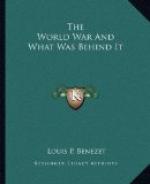How the peasants looked upon war.—War the opportunity of the fighting men.—The decreasing power of barons.—The growth of royal power.—How four little kingdoms became Spain.—Other kingdoms of Europe.—The rise of Russia.—The Holy Roman Empire.—The electors.—The rise of Brandenburg.—The elector of Brandenburg becomes King of Prussia.—Frederick the Great.—The seizure of Silesia and the consequent wars.
You have already been shown how in the early days of the feudal system, the lords, with their squires, knights, and fighting men made up a class of the population whose only trade was war, and how the poor peasants were compelled to raise crops and live stock enough to feed both themselves and the fighting men. These peasants had no love for war, as war resulted only in their losing their possessions in case their country was invaded by the enemy. The fighting men, on the other hand, had nothing to do unless war was going on, and as those who were not killed returned from a war with rich plunder in case they were victorious, they were always looking for a chance to start trouble with some neighboring country.
In those days, kings cared little what their nobles did, so long as the nobles furnished them with fighting men in times of war. As a result, one county in a certain kingdom would often be at war with a neighboring county. The fighting man either was killed in battle or he came out of it with increased glory and plunder, but the peasants and the common people had nothing to gain by war and everything to lose. As we have seen, force ruled the world, and the common people had no voice in their government. The workers were looked down upon by the members of the fighting class, who never did a stroke of work themselves and considered honest toil as degrading. In fact, as one writer has said, the only respectable trade in Europe in those days was what we today would call highway robbery.
France and England in the 15th Century
Gradually in most of the European countries the king was able to put down the power of his nobles and make himself master over the whole nation. In this way a strong central power grew up in France. After the death of Charles the Bold, Duke of Burgundy, in 1477, no noble dared to question the leadership of the king of France. The same thing was true in England after the battle of Bosworth in 1485, which resulted in the death of King Richard III and the setting of the Tudor family on the throne.
Spain and Other Kingdoms
Spain had been divided into four little kingdoms: Leon, Castile, Aragon, and Granada, the latter ruled by the Moors. The nation marriage of Ferdinand of Aragon to Isabella of Castile and Leon joined the three Christian kingdoms into one, and after 1492, when the Moors were defeated and Granada annexed to the realm of Ferdinand and Isabella, Spain became one kingdom. About this time, also, there had grown up a strong kingdom of Hungary, a kingdom of Portugal, a kingdom of Poland, and one of Denmark. Norway was ruled by the Danes, but Sweden was a separate kingdom. In Russia, Czar Ivan the Terrible (1533-84) had built up a strong power which was still further strengthened by Czar Peter the Great (1690-1725).




